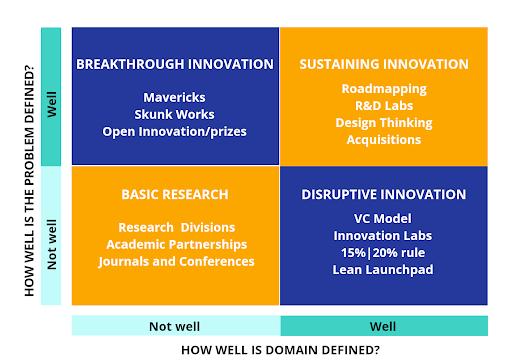In this blog, you’ll get familiar with the four main types of innovation along with more other types & why it matters in the business world. Innovation is part of a Business Organization.
A study by Bern University says, only 15 percent of companies will make it to the 15 years mark whereas only 5 percent will reach up to 50 years mark.
There is no FIXED process of innovation. As the competition changes, technology shifts and the marketplace evolves – companies strive to get better to meet customer needs.
Innovation is a continual & commercial process. its success is dependent on the all in all market response. Markets are described as economics at the macro level.
Whereas at the micro-level it is best described as the success of the value proposition of products & services.
To measure the success of a value proposition one must compare it with a competitor’s value proposition and the beneficial value a consumer receives.
Innovation will be to bring a significant change to the existing product. With this in place, various types of innovations got discovered in the market.
These innovation types are categorized based on their effect on the market, its cost, benefits & value proposition to customers. Though it has different features, a small part of them still laps over.
So, let’s get started with what are the 4 types of innovation first.
What are the 4 types of innovation?

-
Basic research
Basic Research aims to improve scientific theories and upgrade the knowledge of the world. It generates the roots for new ideas, principles, and innovations.
Basic research is not immediately brought into existence in the physical world but on white papers. It is the base for future progress and developmental needs.
For eg: The existence of computers lies in the research in pure mathematics, conducted years ago when it’s zero sources for practical application.
It’s a crucial form of innovation that creates a pipeline for new things that are about to enter the market in the future.
Mostly the researches are backed by Universities and Research Development Centers. Large companies have their own team of expert researchers.
Google provides funds to 250 academic research projects & invites 30 top scholars to spend sabbaticals at Google every year.
Thus, indicating the gravitas of the basic research in innovation.
-
Disruptive Innovation
The term disruptive innovation was coined by Clayton Christensen in his book- The Innovator’s Dilemma in 1995. It refers to the creation of the own market network. It compels customers to shift from traditional methods to new methods.
A market gets disrupted when new technology rolls out to replace the old and outdated ones. Disruptor provides an innovative alternative that has the capability to cater to customer needs in a better way.
So, disruptive innovation is generally made by startups. An existing market player will not disrupt the market as it faces limitations because of the business network.
Disruptive innovation has the greatest drawback & that is RISK !!! It’s a big task accompanied by the greatest risks while entering the market.
It’s difficult to estimate the market response & to understand what works and what doesn’t works. It is naturally a tortoise of the market race. It happens slowly & steadily to win in the end and not at once.
To avoid being disrupted or lose out like the rabbit of the story- one has to keep their eyes open to new entrants & innovate new strategies and ideas to survive in the market.
A well-known example of Disruptive innovation is Netflix & Blockbuster.With 6 years Blockbuster was out of business as it failed to pivot its business strategy and hence faces the stiff competition laid by Netflix.
-
Breakthrough Innovation
Aren’t breakthrough & disruptive innovation the same? NO, it’s not. But Yes, it overlaps at a few folds. Amazon started as a breakthrough innovation for ordering books via mail.
It evolved and reshaped itself as an e-commerce firm to become a disruptor. Therefore, breakthrough innovation is an amalgamation of all incremental innovations that push the company beyond the expected level.
-
Sustaining Innovation
Most of the innovations in organizations are sustaining innovations. This innovation aims for organizational sustainability in the market. It implies improving the existing value network to satisfy consumer needs.
So, sustainable innovations are lower in risk and focus on shifting profits to the upper level.
Clayton Christensen remarks – “Some sustaining innovations are the incremental year-by-year improvements that all good companies grind out. Other sustaining innovations are breakthrough, leapfrog-beyond-the-competition products. It doesn’t matter how technologically difficult the innovation is, however: The established competitors almost always win the battles of sustaining technology.
Because this strategy entails making a better product that they can sell for higher profit margins to their best customers, the established competitors have powerful motivations to fight sustaining battles. And they have the resources to win.”
Big Companies leverage this strategy as it makes easy & cost-effective pay-offs. Understanding the position of the company and the goals to be achieved can act as a guide in the advancement of business strategies.
These four types of innovation are a version created by Greg Satell, an entrepreneur & innovation expert. Previously many scholars had created their own version types of Innovation.
Clayton Christensen called his categories- Performance Improving, Efficiency, and Market Creation. Here, the first category is synonymous with sustainable innovation whereas the other two come under the same type- Disruptive innovation.
On the other side, the Organization for Economic Co-operation and Development (OECD) defines its categories as Product innovation, Process innovation, Marketing innovation & Organisational innovation.
Along with Satell’s categories, the following three innovations and Doblin’s framework of innovation is widely approved forms of innovation.
Other Innovation Types
-
Architectural Innovation
Architectural Innovation is upgrading the existing technology or structuring of present inventions. This strategy is useful as long as the market is receptive & customers are accepting the architectural change.
The risk is low in this strategy. As it’s easy to go back to the previous product architecture in case it fails in pilot testing. One of the interesting examples is the evolution of bicycles.
The bicycles have evolved from german draisine in 1818- a couple seated Quadracycle(4 wheelers) – high wheel bicycle to safety bicycle in 1984- racer bicycles- mountain bikes & now hybrid and commuter bicycles.
Hence, the architectural innovation gets updated with new skills, ideas & technologies to make the existing product better.
-
Radical Innovation
Radical Innovation is a similar form of innovation to disruptive innovation. It is RARE but in the recent past, its frequency has increased. In this innovation, the preference is always for technological advancement.
It solves big global problems. It gives people what they need and even what they didn’t even know they needed. So, this changes the complete chapter of the economy.
Hence, this innovation brings significant developments in the daily walks of human life. For example- The Internet. It brought radical advancements in the methods of communication, marketing, and media.
-
Incremental Innovation
Incremental Innovation implies increasing value to customers in the existing market with present technology.
There is no deliberate focus on technological upgradation or creating a new market. However, innovation can drive new customers or market unknowingly.
So, one of the recent examples is- Instagram added the new feature of reels for short video communication that gives higher reach and engagement to content creators.
Doblin’s Ten Types of Innovation
The ten types of innovation presented by Doblin are also known as ‘The Doblin Framework”. Doblin is an innovation-focused firm by Deloitte.
With years of research and assessing 2000 business innovations., Doblin observed- An innovation can be categorized into 10 distinct dimensions. So, they bill this as a diagnostic tool for assessing organizational innovations.
It proposes to analyze the competitive business environment and reveal gaps and potential opportunities while introducing something innovative in the market.
Doblin’s 10 dimensions of innovation are categorized into 3 parts- Business Model Innovation, Product Innovation, and Marketing Innovation.
-
Business Model Innovation:
The following types of innovation are focused on the internal activities, working structure, and business system of an enterprise.
-
Profit Model
Profit Model innovation looks up new ways to convert the firm’s value proposition into cash. It let’s firm know what customers need and finds the area for the best pricing strategies.
Moreover, it challenges industries to toss off old presumptions of what to offer, what customer desires, what to price, or how to generate revenue.
-
Network
It involves improving network processes by harnessing technologies, channels & offerings of other companies. It apprises to take advantage of other’s capabilities & service offerings to build networks.
Thus, helping executives in risk-sharing & forming alliances with ventures and even competitors.
-
Structure
It ensures alignment & organization of the company’s talents and assets. It involves value creation by improving the structure of talent resources, research & development, IT, etc.
Thus, setting the bar of high standards and attracting productive and accomplished talents to the organization.
-
Process
A Process Innovation involves improving the operations and activities that present the organization’s offerings to customers.
In addition, it can also take the form of a patented approach that offers benefits to the organization & keeps them ahead of the competitors.
-
Product Innovation:
The following innovations are focused on the organization’s center products and services or its collections.
-
Product Performance
It encompasses developing unique features and functionalities of products. It includes all products from recent offerings to already existing products.
Therefore, the secret is to have only value offerings or to be better than a competitor’s offerings.
-
Product System
It includes creating connections between individual products and services to strengthen the offerings.
Thus enhancing the value of the core product by adding complementaries to it. This system delights customers and makes them stay away from competitors.
-
Marketing Innovation:
The following innovations are focused on customer-centric components of an organization and its business system.
-
Service
It implies enhancing the value of organizational offerings. It guides customers to make the best use of the products by revealing their features and functionality in the right way.
Also, it focuses on smoothening and providing a delightful customer experience by fixing up rough patches in the customer journey.
-
Channel
It involves enhancing the mechanism to deliver offerings to customers. The goal is to give customers when they want it, what they want, and how they want it, with minimal to zero barriers.
-
Brand
People get naturally attracted to brand reputation. Brand innovation implies improving branding strategies. Thus, making the offerings an unforgettable & undeniable buying option.
So, brand innovation has the potential to add value, meaning, and intent to organizational offerings.
-
Customer Engagement
It implicates how deeply & profoundly the company connects with its users. It involves crafting new techniques and methods to get meaningful insights about customers. Thus, getting access to unexplored avenues to drive customer satisfaction.
Why these 4 types of innovation matter?
The main reason for innovation is: Maintaining relevancy and surviving in the market.
As the World is ever-evolving, there are unexplored spheres that have the potential to drive monetary benefits to an organization.
It is an indispensable factor in surviving longer and withstanding competitors. So, it succors companies to keep competitors at bay, and better fulfill customers’ needs.
Innovation can be as big as introducing new technology and can be as small as upgrading a feature of the product.
It harnesses the power of the humans both internally (employees) and externally (customers) to stay relevant for keeping with the market needs.
Thus introducing new products and services and attenuate market challenges and competition.
Take Away
Given the importance of innovation, the matter of fact is innovation is DIFFICULT. A survey reveals a lack of skills and capabilities is the main hindrance to organizational innovation.
Every type of innovation has different requirements, the key is to determine your approach through extensive review and analyzing the products and services and state of the company.
Once the problem is identified it’s easy for companies to innovate their next changing strategy. So, keeping an eye on market changes will set the company’s growth in the right direction.
Got the next innovative business idea? Looking for funds to bring it into the physical world? We got you covered !!!








